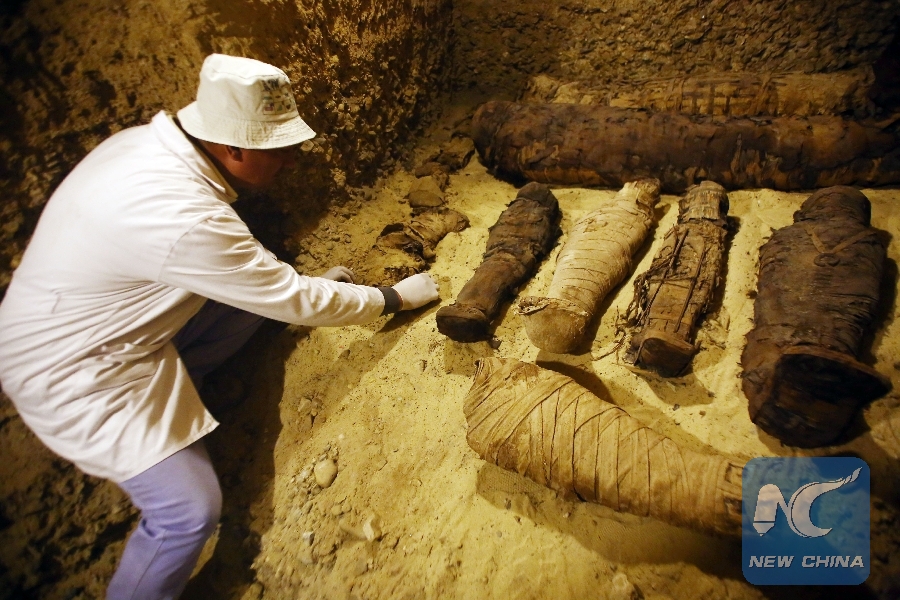
An archaeologist excavates mummies inside the newly excavated tombs in Tuna el-Gebel necropolis of Minya province south of the capital Cairo, Egypt, Feb. 2, 2019. (Xinhua/Ahmed Gomaa)
by Mahmoud Fouly
MINYA, Egypt, Feb. 6 (Xinhua) -- The excavation works by the Egyptian Ministry of Antiquities revived over the past couple of years leading to several archeological discoveries after more than six years of suspension, Mostafa Waziri, secretary general of Egypt's Supreme Council of Antiquities (SCA), told Xinhua in a recent interview.
"The SCA had stopped excavation works after the 2011 popular uprising due to the lack of financial support, as excavation is costly and we had to suspend it for more than six years," Waziri said in the open-air interview in the desert of Tuna el-Gebel necropolis in Minya province south of the capital Cairo.
He explained that by the end of 2016, "things started to gradually flourish and we made some impressive archeological discoveries by purely Egyptian missions."
"Now in 2019, we announced a new discovery of three tombs including more than 50 mummies in Tuna el-Gebel necropolis, some of which have been moved to a nearby storehouse and we have more than 40 mummies inside the tombs in a perfect condition of preservation," he said.
Waziri noted that the mummies discovered in Tuna el-Gebel must have belonged to high-ranking people due to the perfect mummification of their bodies.
"We call Tuna el-Gebel 'a virgin area' for it is a very promising area with more and more ancient tombs to be discovered. I expect to find about 40 or 50 shaft tombs in this area during future excavations," said the Egyptian top archeologist.
The SCA chief enlisted the results of excavation works over the past two seasons, noting that the monument-rich southern province of Luxor was the "springboard."
"Our springboard was Luxor when we discovered a Pharaonic cemetery with dozens of coffins in April 2017, and later in September, we discovered an ancient goldsmith's tomb in the famous Valley of Kings," he told Xinhua.
He said that in December 2017, also in Luxor, a mission unearthed two 3,500-year-old tombs. "At that time, I was general director of Luxor antiquities before I was promoted to SCA chief and moved to the capital Cairo."
Giza pyramids plateau was home to last year's first excavation fruit, when archeologists in February 2018 found in the western cemetery an Old Kingdom tomb of a woman called Hetpet.
"After that, by the end of February 2018, we started excavation in al-Garifa area near Tuna el-Gebel necropolis, where we made a wonderful discovery of a Pharaonic cemetery including eight tombs, 40 coffins and about 1,000 statues," Waziri said.
Also in 2018, in Saqqara area near the Giza pyramids, archeologists discovered an ancient mummification workshop, a cemetery of sacred animals and, by the end of the year, a tomb of an ancient well-connected man named Wahtye.
"We have many other archeological discoveries to be announced in 2019. We will not stop out excavations and discoveries nationwide," Waziri said enthusiastically.
On Wednesday morning, the SCA chief paid a visit to Luxor to follow up the work of the first Egyptian-Chinese mission at Montu Temple north of the world famous Karnak Temple Complex.
"The Chinese archeologists are doing a great job with their Egyptian counterparts in the initial preparation and archeological documentation works in the site in the first season," Waziri told Xinhua.
He pointed out that the Chinese archeologists had examined several sites before they chose Montu Temple north of Luxor's Karnak Temple Complex.
"In the coming season, the joint mission will start the reassembly and restoration works of some of the scattered pieces and ruins of Montu Temple," he said.
The mission started in November last year and may continue for at least four or five years until it brings Montu Temple to light, according to the SCA chief.
"The mission is a nucleus for Egyptian-Chinese archeological cooperation that started in one place and will continue to cover different archeological sites in Egypt," the top archeologist told Xinhua.

